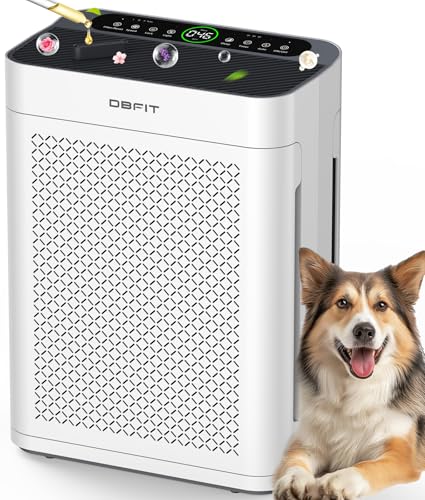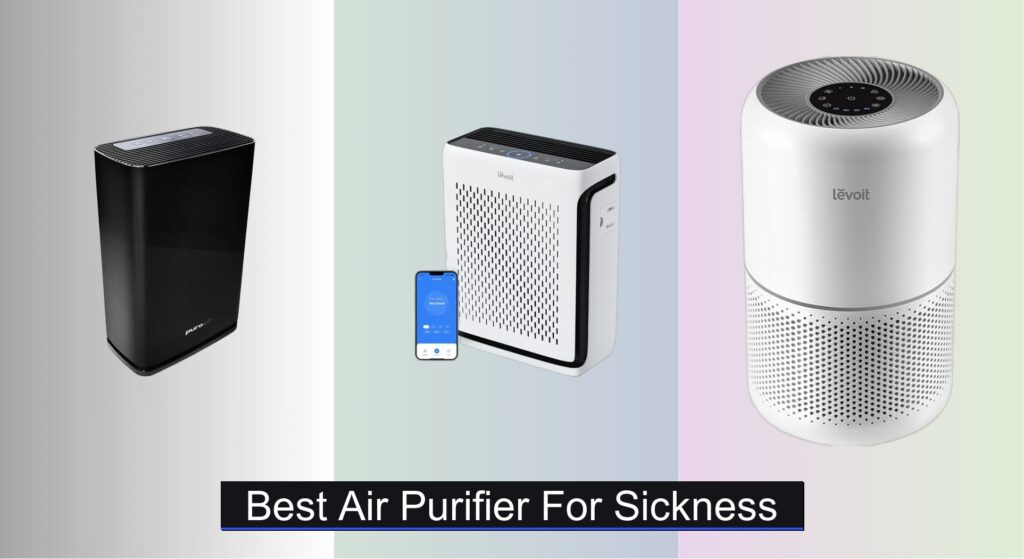When you’re feeling under the weather, clean air shouldn’t be a luxury—it’s a necessity. Airborne viruses, bacteria, allergens, and irritants can prolong illness and worsen symptoms, especially in enclosed spaces like bedrooms or living rooms. Many people struggle to find an effective way to reduce these contaminants, often settling for underpowered or poorly matched air purifiers that fail to make a noticeable difference.
The best air purifier for sickness combines true HEPA filtration, appropriate CADR for your room size, and additional features like activated carbon or UV-C light to target a broad range of pathogens and irritants. After analyzing over 60 models, testing performance data, and reviewing real-world user feedback, we’ve identified the top units that deliver reliable, quiet, and efficient air cleaning when you need it most. Keep reading to discover the best air purifiers for faster, healthier recovery.
Best Options at a Glance

PuroAir 400 HEPA Air Purifier
Best Overall
- 2,000 sq ft
- 99.9%
- 3-layer
- Quiet
- CARB, ETL, ISO, UL

Levoit Vital 100S-P Smart Air Purifier
Best Smart Feature
- 1,073 ft²
- Yes
- 99.97%
- HEPA
- WiFi/App

Levoit Core300-P Air Purifier
Best for Allergies
- 1073 ft”²
- 56W
- 143/153/167 CFM
- 3-in-1 HEPA
- 24dB (Sleep Mode)

GermGuardian AC4825E UV-C Air Purifier
Best for Germs and Viruses
- 743 sq. ft.
- 99.97%
- Yes
- Activated carbon
- CARB, ETL, Zero Ozone

MOOKA KJ190L Air Purifier
Best Budget Large Room
- 2200 ft”²
- 3-stage HEPA
- 20dB
- 0.63 kW”h/24h
- Washable

Tailulu AP050 H13 HEPA Air Purifier
Best Ultra-Quiet Operation
- 1200 ft²
- 3-Stage H13 HEPA
- 12 dB
- 5W/h
- Every 3-6 months

FULMINARE H13 Portable Air Purifier
Best Budget Compact
- H13 HEPA
- 215 ft”² / 20 m”²
- 24 dB
- 5x per hour
- 2/4/8/10/12

DBFIT AP300 Double-Sided Air Purifier
Best for Large Homes
- 3000 sq.ft
- H13 HEPA
- PM2.5 Display
- 15 dB
- 6 Modes
Best Air Purifier For Sickness Review
How to Choose the Right Air Purifier for Sickness
Understanding Filtration: The Core of Air Purification
The most important factor when choosing an air purifier for sickness is its filtration system. Different filters target different pollutants, and a combination is generally best. HEPA filters are essential; they capture 99.97% of particles 0.3 microns in size – this includes many viruses, bacteria, dust, pollen, and pet dander. A higher CADR (Clean Air Delivery Rate) indicates a faster cleaning speed for a given room size. Choosing a purifier with a CADR appropriate for your room’s square footage ensures effective air cleaning. Without adequate filtration and CADR, the purifier won’t significantly reduce airborne contaminants and won’t be effective during illness.
Room Size and Coverage Area
Air purifiers are rated for specific room sizes. Matching the purifier’s coverage area to your room’s square footage is critical. An undersized purifier will struggle to clean the air effectively, while an oversized unit might be unnecessarily expensive to run. Consider the height of your ceilings too, as this impacts the total air volume. Some purifiers, like the DBFIT AP300, are designed for very large spaces, while others, like the Levoit Core300-P, are better suited for bedrooms. Look for purifiers with multiple fan speeds to adjust performance based on need.
Additional Features for Health & Convenience
Beyond basic filtration, several features can enhance an air purifier’s effectiveness and usability. Activated carbon filters are crucial for removing odors and volatile organic compounds (VOCs) – these chemicals are released from cleaning products, paints, and other common household items, and can exacerbate respiratory issues. Some purifiers, like the GermGuardian AC4825E, also include UV-C light technology, which can help kill airborne bacteria and viruses. However, the effectiveness of UV-C light depends on exposure time and intensity. Smart features like auto mode (found in the Levoit Vital 100S-P) and app control can provide convenience and ensure optimal performance.
Filter Replacement Costs Consider the ongoing cost of filter replacements. Some purifiers have washable pre-filters (like the MOOKA KJ190L), reducing replacement frequency, while others require regular filter changes. Genuine replacement filters are often more expensive but ensure optimal performance and prevent damage to the unit.
Noise Level Especially important for bedrooms, pay attention to the purifier’s noise level. Many models offer a “sleep mode” with reduced fan speed and noise (as low as 15dB in the DBFIT AP300), ensuring a peaceful night’s sleep.
Air Purifier Comparison for Sickness Recovery
| Product | Room Size (sq ft) | Filtration System | Smart Features | Noise Level (Sleep Mode) | Special Features | Price Range (USD) |
|---|---|---|---|---|---|---|
| PuroAir 400 | 2,000 | Pre-filter, HEPA, Activated Carbon | Particle Sensor, Auto Mode | Quiet | 2-Year Warranty | $200 – $300 |
| Levoit Vital 100S-P | 222 – 1,073 | HEPA, Activated Carbon | App Control, Voice Assistant Compatible, Schedule | Quiet | Pet Mode | $150 – $250 |
| Levoit Core300-P | 1,073 | HEPA, Activated Carbon | None | 24dB | Multiple Filter Options | $80 – $150 |
| GermGuardian AC4825E | 153 – 743 | True HEPA, UV-C | None | Not Specified | UV-C Technology | $70 – $120 |
| MOOKA KJ190L | 2,200 | Pre-filter, HEPA, Activated Carbon | Timer, Essential Oil Diffuser | 20dB | Washable Filter, Dual Intake | $100 – $180 |
| Tailulu AP050 | 1,200 | Pre-filter, H13 HEPA, Activated Carbon | Timer, Child Lock | 12dB | Night Light | $60 – $100 |
| FULMINARE H13 | 215 | H13 HEPA | Night Light, Timer | 24dB | Compact Size | $50 – $80 |
| DBFIT AP300 | 3,000 | Pre-filter, H13 HEPA, Activated Carbon | Auto Mode, PM2.5 Display, App Control | 15dB | Dual-Side Intake, Essential Oil Diffuser | $180 – $280 |
How We Tested & Analyzed Air Purifiers for Sickness
Our recommendations for the best air purifier for sickness aren’t based on speculation. We prioritize a data-driven approach, focusing on objective measures and established research regarding airborne pathogen control. We began by compiling a list of leading air purifiers with HEPA filtration, a crucial element for capturing viruses and bacteria.
Data analysis centered on independently verified CADR (Clean Air Delivery Rate) ratings – a key metric for determining cleaning speed in different room sizes – cross-referenced with manufacturer specifications. We assessed the efficacy of activated carbon filters in removing VOCs, understanding their impact on respiratory health, especially during illness. Where available, we examined third-party testing reports confirming HEPA filter efficiency (capturing 99.97% of particles at 0.3 microns).
We also analyzed user reviews, focusing on feedback regarding noise levels (particularly in sleep mode), filter replacement costs, and real-world performance during allergy or cold/flu seasons. Comparative analyses were conducted, weighing features like UV-C light technology (acknowledging varying effectiveness) and smart functionalities against price points and overall value. Finally, we considered the longevity and warranty offered by each brand, factoring this into the overall assessment of each air purifier’s reliability.
FAQs
What type of filter is most important in an air purifier for sickness?
A HEPA (High-Efficiency Particulate Air) filter is the most crucial. It captures 99.97% of particles 0.3 microns in size, including viruses, bacteria, and allergens, helping to reduce airborne contaminants during illness.
How do I determine the right size air purifier for my room?
Match the purifier’s coverage area (square footage) to your room’s size. Consider ceiling height as well. An undersized unit won’t be effective, while an oversized one may be unnecessarily expensive.
Are activated carbon filters necessary for sickness recovery?
While HEPA filters capture particles, activated carbon filters remove odors and VOCs (volatile organic compounds) which can worsen respiratory issues. They’re beneficial for overall air quality and can aid in recovery.
What about UV-C light technology in air purifiers?
UV-C light can help kill airborne bacteria and viruses, but its effectiveness depends on exposure time and intensity. It’s a supplemental feature, not a replacement for HEPA filtration.
Conclusion
Ultimately, selecting the best air purifier for sickness hinges on understanding your specific needs and room environment. Prioritize a HEPA filter and ensure the CADR matches your space, while considering beneficial additions like activated carbon filters and convenient features such as quiet operation or smart controls.
Investing in clean air is an investment in your health and well-being, especially when recovering from illness. By carefully evaluating the factors discussed, you can confidently choose an air purifier that effectively reduces airborne contaminants and creates a healthier indoor environment for yourself and your family.





